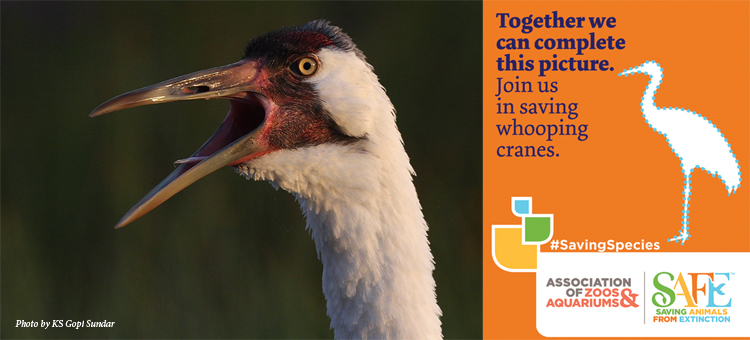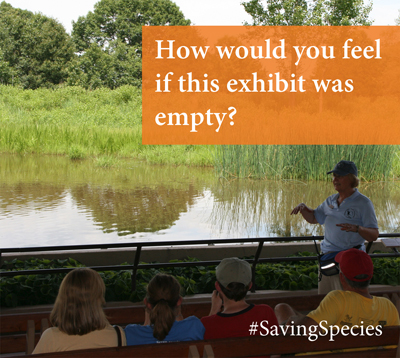
Contact: Cully Shelton, Interpretive Programs Manager, 608-356-9462, ext. 114
Twitter: @savingcranes, #savingspecies
Endangered Species “Vanishing” from the International Crane Foundation
Occurring on the tenth anniversary of Endangered Species Day, the “vanishing” animals
are part of a national effort to highlight the growing extinction crisis.
Baraboo, Wisconsin – In observance of the tenth anniversary of Endangered Species Day, Whooping Cranes will “vanish” from their exhibits at the International Crane Foundation. Their implied disappearance is meant to highlight the growing need to save endangered species from extinction.
“Let’s face it. If there were no more Whooping Cranes left on our planet, that would be an awful situation to find ourselves in,” Cully Shelton, International Crane Foundation Interpretive Programs Manager said. “Thankfully, we are in a position right now to prevent that from happening. That is why we are asking our visitors to pause and consider what extinction would look and feel like.”
The vanishing animals from the International Crane Foundation are part of a larger, national effort organized by the Association of Zoos & Aquariums (AZA), of which the International Crane Foundation is a member. The 229 accredited members of the AZA are coming together to help the public consider what it would be like to not be able to see, learn from, or connect with these incredible animals again. Endangered Species Day marks the launch of a global campaign by AZA SAFE: Saving Animals From Extinction.
 For decades, AZA-accredited zoos and aquariums have been leaders in species survival. Through SAFE, AZA-accredited zoos and aquariums will convene scientists and stakeholders globally to identify the factors threatening species, develop Conservation Action Plans, collect new resources, and engage the public.
For decades, AZA-accredited zoos and aquariums have been leaders in species survival. Through SAFE, AZA-accredited zoos and aquariums will convene scientists and stakeholders globally to identify the factors threatening species, develop Conservation Action Plans, collect new resources, and engage the public.
In 2015, SAFE will focus on 10 species and then add an additional 10 species each year for the next 10 years. The inaugural 10 species include: African penguin, Asian elephant, Black rhinoceros, Cheetah, Gorilla, Sea Turtles, Vaquita, Sharks, Western pond turtle, and the Whooping Crane.
“AZA aquarium and zoo conservationists have identified more than 100 species facing the greatest threats and where accredited zoos and aquariums have unique conservation and science knowledge to contribute,” Jim Maddy, AZA President and CEO, said. “Today, we’re demonstrating just how profound the loss would be if we don’t take action now to protect wildlife. More importantly, we are also explaining to the public just what AZA-accredited zoos and aquariums are doing to save animals from extinction.”
The International Crane Foundation is working to protect the Whooping Crane – one of the rarest and most endangered bird species in North America. The International Crane Foundation works to conserve the naturally-occurring Whooping Crane flock that migrates between breeding grounds in Wood Buffalo National Park, Canada and wintering grounds in coastal Texas, and the reintroduction of additional self-sustaining populations of Whooping Cranes according to the Whooping Crane Recovery Plan.
Public Asked to Help Save Animals from Extinction
One of the easiest actions citizens can take is to visit the International Crane Foundation. Doing so directly supports the collaborative efforts of hundreds of researchers, field conservationists, and scientists from AZA-accredited zoos and aquariums working to save animals from extinction.
###
The International Crane Foundation works worldwide to conserve cranes and the ecosystems, watersheds, and flyways on which they depend. To learn more, visit www.savingcranes.org.
AZA SAFE: Saving Animals From Extinction combines the power of zoo & aquarium visitors with the resources and collective expertise of zoos and aquariums accredited by the Association of Zoos & Aquariums and partners to save animals from extinction. Together we are working on saving the most vulnerable wildlife species from extinction and protecting them for future generations. To learn more, visit AZAsavingspecies.org.
